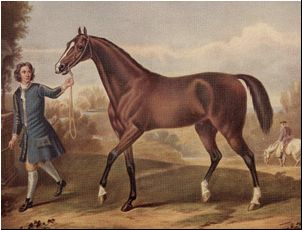Hide
Buttercrambe: The Darley Arabian.
hide
Hide
Hide
BUTTERCRAMBE:
Source=h:/!Genuki/RecordTranscriptions/NRY/ButtercrambeArabian_A.txt The Darley Arabian, by Peter Darley.

Buttercrambe has an important association with the history of British Thoroughbred racehorses.
In 1702 Thomas Darley; born Aldby Park 1664; while serving as Her Majesty's Consul to the Levant (Syria) during the reign of Queen Anne; bought a Arabian horse from Sheik Mirza for his father, Richard Darley.
There are conflicting stories about how much Darley paid in exchange for the horse, some reports say 300 golden sovereigns, and others say a flintlock rifle. The confusion may have something to do with subsequent events. It is said that after Darley had paid for the horse, the Sheik was reluctant to hand over the animal, and tried to renege on the deal. Darley seems to have taken a typical 'no nonsense' Yorkshire approach to this, for in 1703, the Sheik allegedly wrote a letter to Queen Anne, complaining that "British sailors had foully stolen" his prize horse. However, history assures us that Darley obtained the horse legally.
The horse was introduced to the family in the following extract from a letter written by Thomas Darley in Aleppo, to his younger brother Richard in England; dated 21st December 1703*1
"--.Since my Father expects I should send him a stallion, I esteem myself happy in a colt I bought about a year and a half agoe, with a desygne to send him ye first good opportunity. He comes four the latter end of March or the beginning of April next; his colour is Bay, and his near foot before, with his both his hind feet, have white upon them, he has a blaze downe his face, something of the largest. He is about fifteen hands high, of the most esteemed race among the Arabs, both by Syre and Dam, and the name of the said race is called Mannicka.
The only fear I have about him at present is that I shall not be able to get him aboard this war time *2, though I have the promise of a very good and intimate friend, the Honble and Revnd Henry Bridges, son to Lord Chandoes, who embarks in the Ipswich, Captain William Waklin, who presume will not refuse taking in a horse for him since his brother is one of ye Lords of ye Admiralty; besides I desynge to go to Scandn to assist in getting him off. Wch, if I call accomplish, and he arrives in safety, I believe he will not be much disliked; for he is esteemed here, where I could have sold him at considerable price, if I had not desygned him for England--."
Few sons could have done so much for their father, however, father Richard died in 1706, being succeeded by eldest son Henry, two years older than Thomas. On Henry's death in 1720, Aldby Park was inherited by his younger sister Jane, wife of John Brewster of Hertfordshire.
Foaled in Syria, late March or early April in the year 1700. Standing at 15 hands when described by Darley in 1703, tall for an Arabian horse of the time. The horse whose original name was "Ras el Fedowi," translated as "The Headstrong One", became immortalised as the Darley Arabian. In Thomas Darley's own words, "he was immediately striking owing to his handsome appearance and exceedingly elegant carriage". Although he never raced, he covered mares at Aldby Park from 1705 until 1719, and lived until the advanced age of 30. His genes added speed to those of stronger English horses of the time. Through his offspring, including his great grandson, the famous and never beaten Eclipse, he has had the greater influence of the three foundation stallions of the Thoroughbred breed. His bloodline is said to be present in 80 or 90% of today's racehorses.
*1 There are several published versions of this letter. I have chosen an extract from the one that looks the most authentic in both style and date. From "The racing Man's Bedside Book" compiled by Julian Bedford.
*2 England was at war with France at the time.
There is a further article on the Darley Arabian on the Thoroughbred Bloodlines web site.
